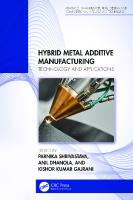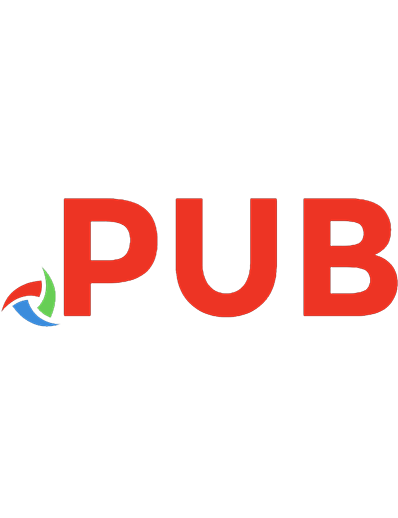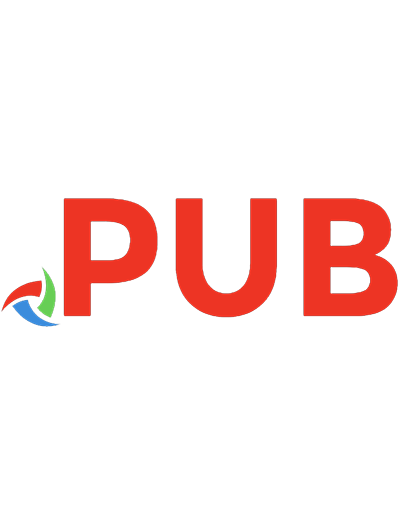Precision Metal Additive Manufacturing 113834771X, 9781138347717
Additive manufacturing (AM) is a fast-growing sector with the ability to evoke a revolution in manufacturing due to its
577 71 163MB
English Pages 418 [419] Year 2020
Table of contents :
Cover
Half Title
Title Page
Copyright Page
Table of Contents
Acknowledgements
Editors
Contributors
Chapter 1 Introduction to Precision Metal Additive Manufacturing
1.1 Introduction to Additive Manufacturing
1.2 Basic Definitions
1.2.1 General Terms
1.2.2 Process Categories
1.2.3 Other Terms
1.3 Towards Precision Additive Manufacturing
References
Chapter 2 Topology Optimisation Techniques
2.1 Introduction
2.2 Topology Optimisation
2.2.1 Density-Based TO Method
2.2.1.1 Problem Formulation
2.2.1.2 Sensitivity Analysis
2.2.1.3 Filtering Techniques
2.2.1.4 Solution Approaches
2.2.1.5 Application Domains
2.3 Topology Optimisation for Precision Metal AM
2.3.1 TO Methods for Avoiding Overhangs in Precision AM Parts
2.3.1.1 Two-Dimensional Overhang Control
2.3.1.2 3D Overhang Control
2.3.1.3 Support Inclusion
2.3.2 TO Methods for Preventing Overheating in Precision AM Parts
2.3.3 Towards TO Methods for Avoiding Distortion in Precision AM Parts
2.4 Challenges and Outlook
References
Chapter 3 Development of Precision Additive Manufacturing Processes
3.1 Introduction
3.2 State of the Art and Insight into Precision Process Development
3.3 Setting Priorities
3.4 Significant Process Parameters
3.4.1 Laser-Related Process Parameters
3.4.2 Scan-Related Process Parameters
3.4.3 Powder-Related Process Parameters
3.4.4 Build Chamber-Related Parameters
3.4.5 Combined Processing Parameters
3.5 Additive Manufacturing Performance Indicators
3.5.1 Mechanical Properties
3.5.2 Dimensional Accuracy
3.5.3 Surface Texture
3.5.4 Part Density
3.5.5 Total Build Time
3.5.6 Energy Consumption
3.5.7 System-Wide Performance Indicators
3.6 Data-Driven Process Improvement
3.6.1 Design of Experiments
3.6.2 Modelling of Process Performance (Quantifying Input/Output Process Relationships)
3.6.2.1 Regression and Statistical Analysis
3.6.2.2 Artificial Neural Network Modelling
3.6.3 Process Optimisation
3.7 Precision Processes in the Domain of Industry 4.0
3.7.1 Real-Time Monitoring of AM Processes
3.7.2 Artificial Intelligence and Decision-Making Systems for Digital Quality Control
3.8 Future Perspectives for Precision AM Processes
3.9 Conclusions
Acknowledgements
References
Chapter 4 Modelling Techniques to Enhance Precision in Metal Additive Manufacturing
4.1 Introduction
4.2 Demystifying AM through Simulations
4.2.1 The Physics of Laser Powder Bed Fusion
4.2.2 Challenges of Length and Time Scales
4.3 Warpage and Distortion Predictions by Macro-Scale Modelling of AM
4.3.1 Understanding Thermal History, Residual Stresses and Distortions
4.3.2 Goals and Challenges in Macro-Scale Modelling of AM Parts
4.3.3 Full-Scale, Reduced-Order and Effective Models
4.4 Tracking Powders, Pores and Melt Pools during AM through Meso-Scale Models
4.4.1 Powder Bed Formation and Representation
4.4.2 Simulating Laser–Material Interactions
4.4.3 Melt-Pool Dynamics in a Powder Bed
4.4.4 Evolution of Porosity during AM
4.4.5 Surfaces and Solidification during AM
4.5 Microstructure Simulations in Precision AM
4.5.1 Understanding the Metallurgical Needs
4.5.2 Metallurgical Modelling Techniques
4.5.3 Revisiting Solidification during AM from a Metallurgical Perspective
4.5.4 Need for Heat-Treatment as Post-Process
4.6 Data-Driven Modelling for Process Windows
4.6.1 Data-Based Models
4.6.2 Digital and Physical Design of Experiments
4.6.3 GIGO Approach to Model Calibration
4.7 Concluding Remarks and Future Outlook
References
Chapter 5 Secondary Finishing Operations
5.1 Introduction
5.2 Basic Definition of Secondary Finishing
5.2.1 What Is Considered to Be Secondary Finishing in This Chapter?
5.2.2 Not Included in the Scope of This Chapter
5.3 Why Do AM Surfaces Need to Be Finished?
5.3.1 Impact of Surface Topography on Function
5.3.1.1 Fatigue Applications
5.3.2 Examples of AM Surfaces
5.4 Specification Standards in Secondary Finishing
5.5 Challenges for Finishing Operations for AM Parts
5.5.1 Typical Operational Challenges for Metal AM Components Due to Surface Morphologies and Topographies
5.5.1.1 Challenges of Surface Topography
5.5.1.2 Supporting Material and Witness Marks
5.5.1.3 Distortion
5.5.2 Geometrical Challenges for Finishing Operations
5.5.3 AM Process Chain Challenges for Finishing Operations
5.5.4 Finishing Challenges for AM in Precision Applications
5.6 Available Secondary Finishing Processes
5.6.1 Conventional Machining Methods
5.6.2 Non-Conventional Machining Methods
5.6.3 Emerging Technologies Developed for AM
5.6.3.1 Chemical Processes
5.6.3.2 Hybrid Mass Finishing and Chemical
5.6.3.3 Hybrid Mass Finishing and Electropolishing
5.6.3.4 Electropolishing Developments
5.6.3.5 Mass Finishing Targeted at AM
5.7 What Processes Are Appropriate for AM?
5.7.1 Narrow Channels
5.7.2 Complex Internal Channels
5.7.3 Internal Cavities (Surface Connected)
5.7.4 Variable Cross-Section Internal Channels
5.7.5 Outer Lattice Surfaces
5.7.6 Inner Lattice Surfaces
5.7.7 Thin Features
5.7.8 Closed Internal Cavities
5.8 Other Considerations for Finishing Operations in AM
5.9 How to Impact AM Design for Finishing
5.10 Future Work
5.10.1 New Processes and Technologies in Development
5.10.1.1 Hybrid AFM
5.10.1.2 Laser Polishing
5.10.1.3 Automation and Modelling
5.10.2 Future of This Field
5.10.2.1 Internal Targeted Finishing
5.10.2.2 Hybrid Technologies
5.10.2.3 Design Processes
5.10.2.4 Specification Standards
5.10.2.5 Automation and Targeted Finishing
References
Chapter 6 Standards in Additive Manufacturing
6.1 Introduction
6.2 AM Standards Roadmaps
6.2.1 America Makes
6.2.2 Identified Gaps in the Roadmaps
6.3 AM Powder Feedstock Characterisation Standards
6.3.1 Feedstock Sampling Strategy
6.3.2 Particle Size Determination and Distribution
6.3.3 Morphology Characterisation Methods
6.3.4 Flow Characteristics
6.3.5 Thermal Characterisation
6.3.6 Density Determination
6.3.7 Chemical Composition
6.4 Processes
6.5 Part Verification
6.5.1 Tensile Properties
6.5.2 Compressive Properties
6.5.3 Hardness Measurement
6.5.4 Fatigue Measurement Methods
6.5.5 Fracture Toughness
6.5.6 Other Properties
6.6 Surface Standards
6.6.1 Profile and Areal Surfaces
6.7 Dimensional Standards
6.7.1 Performance Verification of Coordinate Measuring Machines
6.8 Non-Destructive Evaluation Standards
6.8.1 Current Standards
6.8.2 Welding Standards
6.8.3 Casting Standards
6.9 Future and Planned Standards Activities
References
Chapter 7 Cost Implications of Precision Additive Manufacturing
7.1 Introduction
7.2 A Primer in Manufacturing Cost Modelling
7.3 Developing an AM Costing Framework
7.4 Specifying a Simple Cost Model for Precision AM
7.5 A Brief Discussion of the Cost Model for Precision AM
7.5.1 Indirect Cost Rates
7.5.2 Capacity Utilisation
7.5.3 Integration with Other Operational Processes
7.5.4 Relationship between Failure Parameters and Costs of Inspection
7.6 Summary and Additional Perspectives
References
Chapter 8 Machine Performance Evaluation
8.1 Introduction
8.1.1 Definitions
8.1.2 Motivation
8.1.3 Background
8.1.4 Organisation of This Chapter
8.2 Three-Dimensional Test Artefacts
8.2.1 Key Contributions to 3D Test Artefacts
8.2.2 Strengths and Challenges of 3D Test Artefacts
8.2.3 Considerations for 3D Test Artefact Design
8.3 Component Testing
8.3.1 Key Contributions to Component Testing
8.3.2 Strengths and Challenges of Component Testing
8.3.3 General Principles of Component Testing
8.3.4 Z-Axis
8.3.5 Directed Energy Deposition Machine Error Motions
8.3.6 Powder Bed Fusion Machine Error Motions
8.3.7 Energy Beam Diagnostics
8.3.8 Non-Geometric Measurements
8.4 Two-Dimensional Test Artefacts
8.4.1 Strengths and Challenges of 2D Test Artefacts
8.4.2 Key Contributions to 2D Test Artefacts
8.4.3 Considerations for Designing a 2D Test Artefact
8.5 Areas for Future Research
Disclaimer
References
Chapter 9 Non-Destructive Evaluation for Additive Manufacturing
9.1 Introduction
9.2 Typical Defects in AM
9.3 NDE Challenges in AM
9.4 NDE Methods – Advantages and Limitations
9.5 NDE Standardisation for AM
9.6 NDE for Qualification in AM
9.6.1 Post-Process Inspection
9.6.2 In-Process Inspection
9.7 NDE Reliability in AM
9.7.1 General Aspects of Experimental Pod Curves
9.7.1.1 General Aspects of PoD Curves Modelled through Experimental Data
9.7.1.2 Mathematical Simulation of PoD Curves
9.7.2 Estimation of Experimental PoD
9.8 Current PoD Performed in AM
9.9 Conclusions and Future Research
Acknowledgements
References
Chapter 10 Post-Process Coordinate Metrology
10.1 Introduction
10.2 Basic Definitions
10.2.1 Surface and Coordinate Metrology Terms and Definitions
10.2.2 General Metrology Terms and Definitions
10.3 Basics for Coordinate Metrology
10.3.1 Coordinate Metrology System Configurations
10.3.2 Coordinate Metrology Software
10.3.3 CMS Alignment
10.3.4 CMS Errors
10.4 Contact Methods
10.4.1 Contact Probe Types
10.4.2 Contact Probe Errors
10.4.3 AM Roughness Issues with Contact Probing
10.5 Optical Methods
10.5.1 Vision Systems
10.5.2 Scanning Optical Probes
10.5.2.1 Time-of-Flight Method
10.5.2.2 Laser Triangulation
10.5.3 Areal Optical Probes
10.5.3.1 Digital Fringe Projection Technique
10.5.3.2 Photogrammetry
10.6 Calibration and Traceability
10.6.1 Current Performance Evaluation Framework
10.6.2 Current Uncertainty Framework
10.6.3 Issues with Non-Contact CMS Performance Evaluation
10.6.4 Towards Calibration of Non-Contact CMSs
10.7 Current Research and Future Look
Acknowledgements
References
Chapter 11 Post-Process Surface Metrology
11.1 Introduction
11.1.1 The Nature of Metal AM Surfaces
11.2 Definitions and Standards
11.2.1 Surface Metrology Terms and Definitions
11.2.2 Relevant Specification Standards
11.2.2.1 Profile Standards
11.2.2.2 Areal Standards
11.2.2.3 Other Standards
11.3 Surface Topography Measurement
11.3.1 System Architectures
11.3.1.1 Profile and Areal Topography Measurement Systems
11.3.1.2 Three-Axis And Five-Axis Topography Measurement Systems
11.3.1.3 Three- and Five-Axis Measurement on AM Surfaces
11.3.2 Surface Topography Datasets
11.3.2.1 Height Maps
11.3.2.2 Triangle Meshes
11.3.3 Contact Methods
11.3.3.1 Stylus Instruments – Basics
11.3.3.2 Stylus Instruments – Uses in AM
11.3.4 Non-Contact, Optical Methods
11.3.4.1 Optical Methods for Topography Measurement – Basics
11.3.4.2 Optical Measurement of Surface Topography – Uses in AM
11.3.5 Non-Contact, Non-Optical Methods
11.3.5.1 Scanning Electron Microscopy – Basics
11.3.5.2 Scanning Electron Microscopy – Uses in AM
11.3.5.3 X-Ray Computed Tomography – Basics
11.3.5.4 X-Ray Computed Tomography – Uses in AM
11.3.6 Performance Comparison of Non-Contact Methods
11.3.7 Pseudo-Contact Methods
11.3.7.1 Scanning Probe Microscopy – Basics
11.3.7.2 Scanning Probe Microscopy – Uses in AM
11.4 Surface Topography Analysis
11.4.1 Topography Data Pre-Processing
11.4.2 Topography Data Pre-Processing for AM Surfaces
11.4.3 Surface Texture Parameters
11.4.3.1 The Arithmetical Mean Deviation of the Roughness Profile – Ra
11.4.3.2 Areal Height Parameters
11.4.3.3 Areal Height Parameters – Uses in AM
11.4.3.4 The Areal Material Ratio Curve and Related Parameters
11.4.3.5 The Areal Material Ratio Curve and Related Parameters – Uses in AM
11.4.3.6 Spatial Parameters
11.4.3.7 Spatial Parameters – Uses in AM
11.4.4 Topography Segmentation and Characterisation of Surface Features
11.4.5 Topography Segmentation and Characterisation of Surface Features – Uses in AM
11.4.6 Characterisation of Full-3D Topographies
11.5 Uncertainty in Surface Topography Measurement and Characterisation
11.6 Current Research and Future Look
References
Chapter 12 X-Ray Computed Tomography
12.1 Introduction
12.2 Fundamentals of Industrial X-Ray Computed Tomography
12.2.1 Evolution of X-Ray Computed Tomography
12.2.2 Industrial CT Systems – Configurations and Components
12.2.2.1 X-Ray Source
12.2.2.2 X-Ray Detector
12.2.2.3 Kinematic System
12.2.3 CT Scanning Process
12.3 Measurement Errors and Traceability
12.3.1 Main Error Sources and CT Image Artefacts
12.3.2 Metrological Performance Verification
12.3.3 Uncertainty Determination
12.3.4 Reference Objects
12.4 Applications of CT Metrology for AM
12.4.1 Dimensional and Geometrical Product Verification
12.4.2 Internal Defect Analysis
12.4.3 Surface Topography Characterisation
12.4.4 Powder Feedstock Characterisation
12.4.5 Product Development and Process Optimisation
12.4.5.1 CT for Product Development
12.4.5.2 CT for Process Optimisation
12.5 Conclusion and Future Look
References
Chapter 13 On-Machine Measurement, Monitoring and Control
13.1 Introduction
13.2 Basic Definitions and Terminology
13.3 Defects and Their Fingerprint in PBF Processes
13.3.1 Causes of Defects
13.3.1.1 Defects Induced by Feedstock Material
13.3.1.2 Equipment-Induced Defects
13.3.1.3 Defects due to Improper Design or Job Preparation
13.3.1.4 Process Setting–Induced Defects
13.3.2 Types of Defects
13.3.2.1 Porosity
13.3.2.2 Residual Stresses, Cracks and Delamination
13.3.2.3 Microstructural Inhomogeneity and Impurities
13.3.2.4 Balling
13.3.2.5 Dimensional and Geometrical Deviations
13.3.2.6 Surface Defects
13.4 On-Machine Sensing Methods and Architectures
13.4.1 Basic Principles
13.4.1.1 Electromagnetic Spectral Ranges for On-Machine Measurements
13.4.1.2 Spatially Integrated Sensors
13.4.1.3 Spatially Resolved Sensors
13.4.2 Data Gathering Levels
13.4.3 On-Machine Sensing Architectures
13.4.3.1 Co-Axial Sensing
13.4.3.2 Off-Axis Sensing
13.4.4 Mapping between On-Machine Sensing, Process Signatures and Process Defects
13.5 On-Machine Measurement
13.5.1 On-Machine Topography Reconstruction
13.5.2 Other Methods
13.6 Statistical Process Monitoring Using On-Machine Sensing
13.6.1 Basic Principles of SPM
13.6.1.1 False Alarms and False Negatives: Type I and Type II Errors
13.6.1.2 Control Charts
13.6.2 Examples of SPM
13.6.2.1 On-Machine Monitoring Example, Level 1
13.6.2.2 On-Machine Monitoring Example, Level 2
13.7 Process Control
13.7.1 Feedback Control
13.7.2 Feedforward Control
13.8 Current Research and Future Look
Acknowledgements
References
Index

![Precision additive metal manufacturing [First edition]
9780429436543, 9781138347717, 9780429791284, 9780429791260, 9780429791277, 0429436548, 0429791267, 0429791275, 0429791283](https://dokumen.pub/img/200x200/precision-additive-metal-manufacturing-first-edition-9780429436543-9781138347717-9780429791284-9780429791260-9780429791277-0429436548-0429791267-0429791275-0429791283.jpg)



![Metal Additive Manufacturing [1 ed.]
111921078X, 9781119210788](https://dokumen.pub/img/200x200/metal-additive-manufacturing-1nbsped-111921078x-9781119210788.jpg)




